|
Advantech PPC-6170
Versatile and highly customizable 17-inch Panel PC for a variety of industrial and commercial applications that require high performance and superior reliability
review by Conrad H. Blickenstorfer -- photography by Carol Cotton
Panel PCs like the Advantech PPC-6170, first introduced in 2013, are designed to bring powerful computing capabilities and excellent connectivity to places where a conventional desktop or notebook computer isn't needed or feasible. That includes factories, warehouses, distribution and control centers, transportation terminals or other demanding environments that are hard on equipment, and demand utmost reliability and 24/7/365 uptime to boot. Systems integrators use this type of hardware in all sort of industrial equipment, as point-of-information terminals, interactive kiosks, point-of-sale systems, commercial gaming platforms, medical projects, and various other deployments.
Reliability and utility are a Panel PC's most important features, and so they are designed as compact, sturdy boxes with display sizes ranging from very small to quite large, usually in the 6 to 21-inch range. As the term implies, Panel PCs are sturdy, full-function PCs (although most are used to do just one thing) designed to be mounted in panel and similar structures. The type of use and and the deployment environment dictate optimal size, features and performance. With a 17-inch display, the Advantech PPC-6170 is a fairly large panel, and one designed as a flexible general purpose product.
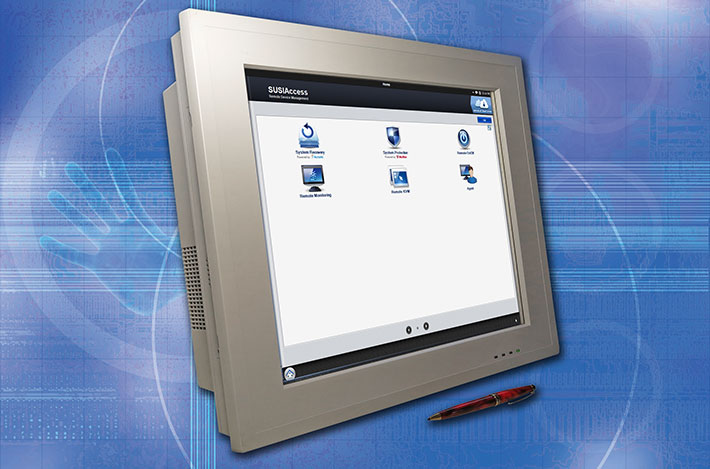
The PPC-6170's 17-inch display places it into a size range generally associated with ATMs and other walk-up human interface panels — not too small and not too large. Measuring 17.4 x 14.3 x 4.5 inches and weighing about 16.5 pounds, the PPC-6170 is a substantial but still manageable piece of equipment. The display offers SXGA 1280 x 1024 pixel resolution, has an analog 5-wire resistive touchscreen, and offers wide horizontal (170 degrees) and vertical (160 degrees) viewing angles for comfortable use. Viewability under most lighting conditions with a fairly strong 350-nit backlight (the average laptop computer has less than 200 nits).
Unlike mobile notebook and tablet computers that require a careful balance between performance, size, weight and power consumption, larger Panel PCs are almost always A/C-powered and have fewer size and weight constraints. The emphasis is on simple, reliable operation and getting the job done. That means tried-and-true industrial-grade components and a minimal number of potential points-of-failure. Cost effectiveness is an issue, too, and so companies like Advantech generally offer broad product lineups, made even broader by the availability of different colors, mounting options, software configurations, and even customization for use in tough environments.
Rational, straightforward design
Panel PCs are, for the most part, designed to be reliable, utilitarian tools for industrial jobs. The emphasis is on simplicity and functionality rather than eye-catching design. The picture below shows the PPC-6170 from the front and all four sides. The light-gray front bezel and housing are tough plastic, the chassis inside is all steel. There are cooling slots and a few other openings indicating that that this is, with the exception of the IP65-protected front bezel, not a sealed system. Note that the front bezel snaps on and can easily be replaced.

Looking at the four sides, you can see that all wired connectivity is concentrated along the bottom side, facing down.
 The PPC-6170's manual shows how to open the panel to install memory, an optional optical drive, a different hard drive and/or a second hard drive, as well as mini-SATA and wireless network cards. It also shows how to install optional riser cards. The PPC-6170's manual shows how to open the panel to install memory, an optional optical drive, a different hard drive and/or a second hard drive, as well as mini-SATA and wireless network cards. It also shows how to install optional riser cards.
Opening the PPC-6170 is exceedingly simple: just nine Philips head screws and the plastic back cover comes right off, revealing the insides of the panel as shown in the picture to the right.
Note the hard drive to the right and the riser card socket board mounted onto the the sturdy metal box enclosing mot of the system's electronics. Also note the dual fans mounted on the box. They are fairly quiet, but needed to keep things cool inside.
Since many Panel PCs are used as HMI (Human Machine Interface) systems, they must have sufficient onboard connectivity to interface with the machinery they are supposed to monitor and control. The PPC-7160 provides both current systems and legacy systems support with three USB 3.0 ports and an additional couple of USB 2.0 ports, two RS232 serial ports, and another that's either 8-channel GPIO or RS232 (by pin header). There is also VGA and HDMI ports for potential secondary screen applications, and dual Gigabit Ethernet jacks for communication with backend servers.
Below is a close-up of the bottom-facing I/O panel of the PCM-6170. Note that our sampler was configured with four extra RJ45 LAN jacks, bringing the panel's total LAN ports to six.

Also note, on the right side, the unit's two (unpopulated) expansion card slots.
OS and Performance
The amount of processing power needed to make a computer fast enough depends entirely on what it is supposed to do, and to a lesser extent on what type of operating system it runs. A general purpose OS such as Microsoft Windows 7 or 8 must be able to do a vast variety of possible tasks. Therefore, they are large and need quite a bit of storage and processing power. Panel PCs usually do just fine with much less processing power because they generally perform a small number of well defined tasks, nothing more and nothing less.
That, however, doesn't mean that customers and system integrators may not have very different requirements, and so the PPT-6170 can be ordered with either Windows 7 or Windows Embedded Standard 7, as well as the older and still popular Windows XP or XP Embedded.
Since customers may use the PPC-6170 for projects requiring various degrees of computing power, Advantech offers this panel with no fewer than four different processors, starting with a fairly low-end Celeron 847E (which is part of the second generation of Intel Core processors, codenamed "Sandy Bridge") running at just 1.1GHz, all the way to a potent "Ivy Bridge" 3rd gen Core i5-3610ME. The table below shows the major specs of the four available processors.
|
Advantech PPC-6170: Available Intel processor options (Click for full spec table)
|
|
PROCESSOR COMPARISON
|
Core i5
|
Core i3
|
Celeron
|
Celeron
|
|
Model
|
3610WE
|
3120ME
|
1020E
|
847E
|
|
Code
|
Ivy Bridge (3rd gen)
|
Ivy Bridge (3rd gen)
|
Ivy Bridge (3rd gen)
|
Sandy Bridge (2nd gen)
|
|
Lithography
|
22 nm
|
22 nm
|
22 nm
|
32 nm
|
|
Cores/Threads
|
2/4
|
2/4
|
2/2
|
2/2
|
|
Base Clock Speed
|
2.70 GHz
|
2.40 GHz
|
2.20 GHz
|
1.10 GHz
|
|
Turbo Speed
|
3.30 GHz
|
no turbo
|
no turbo
|
no turbo
|
|
Thermal Design Power (TDP)
|
35 watts
|
35 watts
|
35 watts
|
17 watts
|
|
Smart Cache
|
3MB
|
3MB
|
2MB
|
2MB
|
|
Integrated graphics
|
HD Graphics 4000
|
HD Graphics 4000
|
HD Graphics
|
HD Graphics
|
|
Graphics base speed
|
650 MHz
|
650 MHz
|
650 MHz
|
350 MHz
|
|
Graphics max speed
|
950 MHz
|
950 MHz
|
1.00 GHz
|
800 MHz
|
|
Intel vPro
|
Yes
|
No
|
No
|
No
|
|
PCI Express Rev.
|
3.0
|
2.0
|
2.0
|
2.0
|
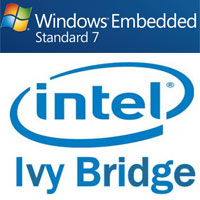 Some commentary about the available chips: three of them are of the "Ivy Bridge" 3rd generation of Core processors, and one is from the predecessor "Sandy Bridge" 2nd generation. What's the difference? Using the 22nm manufacturing process, "Ivy Bridge" brought increased efficiency, lower power consumption, and much better graphics performance. Add to that native USB 3.0 and PCIe 3.0 support in higher-end chips and it's no surprise that Advantech built this panel primarily for Ivy Bridge chips. However, the 3rd Gen is cross-compatible with the 2nd Gen, and so Advantech threw in the low-end Sandy Bridge Celeron. Some commentary about the available chips: three of them are of the "Ivy Bridge" 3rd generation of Core processors, and one is from the predecessor "Sandy Bridge" 2nd generation. What's the difference? Using the 22nm manufacturing process, "Ivy Bridge" brought increased efficiency, lower power consumption, and much better graphics performance. Add to that native USB 3.0 and PCIe 3.0 support in higher-end chips and it's no surprise that Advantech built this panel primarily for Ivy Bridge chips. However, the 3rd Gen is cross-compatible with the 2nd Gen, and so Advantech threw in the low-end Sandy Bridge Celeron.
Our review PPC-6170 came with the top-of-the-line Core i5-3610ME, a very competent performer with a base clock speed of 2.7GHz and a maximum turbo speed of 3.3GHz. None of the other chips support turbo speed. It's also the only one to support PCI3 3.0, which can make a difference, and it's also the only one to support Intel vPro and a number of other Intel technologies that may or may not be needed for an application, such as Intel Virtualization for Directed I/O, Intel My WiFi, AES New Instructions, and Trusted Execution Technology.
To show where the Core i5-3610ME-equipped PPC-6170 stands in terms of relative performance, we ran our standard benchmark suites on it. We're also listing the results of the Atom D2550-powered Advantech PPC-3120 we tested in 2013, the Core 2 Duo-based PPC-L157T, the Atom D525 powered PPC-L158T and the Atom D510 based Advantech UTC-520 touch terminal, both of which we tested in 2012. Here's how the devices compare:
|
PERFORMANCE COMPARISON PASSMARK
|
PPC-6170
|
PPC-3120
|
PPC-157T
|
PPC-L158T
|
UTC-515
|
|
Year tested
|
2014
|
2013
|
2010
|
2012
|
2012
|
|
Intel Processor
|
Core i5-3610ME
|
Atom D2550
|
Core 2 Duo T7400
|
Atom D525
|
Atom D510
|
|
Product type
|
Panel PC
|
Panel PC
|
Panel PC
|
Panel PC
|
Panel PC
|
|
Clock speed
|
2.70GHz
|
1.86GHz
|
2.16GHz
|
1.80GHz
|
1.66GHz
|
|
Thermal Design Power (TDP)
|
35 watts
|
10 watts
|
34 watts
|
13 watts
|
13 watts
|
|
CPU Mark
|
2,816
|
554
|
1,292
|
552
|
512
|
|
2D Graphics Mark
|
429
|
40
|
286
|
150
|
154
|
|
Memory Mark
|
927
|
260
|
552
|
255
|
236
|
|
Disk Mark
|
291
|
548
|
460
|
497
|
261
|
|
3D Graphics Mark
|
291
|
71
|
38
|
14
|
12
|
|
Overall PassMark
|
1,081
|
320
|
585
|
317
|
256
|
PERFORMANCE COMPARISON
CRYSTALMARK 2004R3
|
PPC-6170
|
PPC-3120
|
PPC-157T
|
PPC-158T
|
UTC-515
|
|
ALU
|
49,581
|
12,391
|
19,311
|
12,992
|
10,772
|
|
FPU
|
47,402
|
9,289
|
22,560
|
9,667
|
9,663
|
|
MEM
|
29,696
|
8,502
|
10,867
|
8,095
|
7,709
|
|
HDD
|
7,065
|
9,195
|
8,231
|
9,112
|
7,357
|
|
GDI
|
13,496
|
1,878
|
4,679
|
2,804
|
2,592
|
|
D2D
|
2,643
|
853
|
3,015
|
4,242
|
3,685
|
|
OGL
|
7,482
|
9,319
|
2,272
|
4,242
|
3,685
|
|
Overall CrystalMark
|
157,365
|
51,427
|
70,935
|
47,705
|
42,501
|
The results, of course, are not a surprise. The heavily performance-oriented PPC-6170 with its Core i5 is much quicker than any Atom-based panel, and also more than twice as fast as the Core 2 Duo-powered PPC-157T, which in its time was a high performer itself. If even more performance is required, note that the 160GB Seagate Momentus 5400 hard drive is not exactly a speed demon; replacing it with a faster disk or SSD would significantly boost the PPC-6170's already impressive overall performance.
iManager

Our test machine came with the Advantech iManager Intelligent Management Tool, a built-in solution chip that's sort of an intelligent self-management agent that can handle various software control functions. It's a quick and easy way to configure the system, enhance system reliability, secure the system, monitor status, manage resources and a lot more.
SUSI (Secure and Unified Smart Interface)
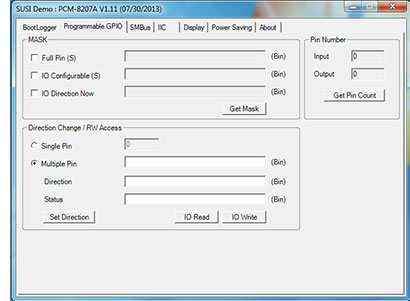 SUSIAccess, preloaded in all Advantech embedded solutions and a demo was also on our review machine, is a remote device management software suite that allows remote device monitoring, cross-platform access, real-time remote configuration, as well as Acronis system recovery and backup. SUSIAccess also provides system security via McAfee Embedded Security solutions, automatic alerts, and remote keyboard, mouse and video access. SUSIAccess, preloaded in all Advantech embedded solutions and a demo was also on our review machine, is a remote device management software suite that allows remote device monitoring, cross-platform access, real-time remote configuration, as well as Acronis system recovery and backup. SUSIAccess also provides system security via McAfee Embedded Security solutions, automatic alerts, and remote keyboard, mouse and video access.
Key benefits of SUSIAccess include the ability to stay in sync with device health status at all time, to reduce
maintenance and via quick access and troubleshooting and
energy costs via intelligent power on/off schedules, complete
protection from unauthorized applications without the need for continuous updating, optimized and interruption-free backup and recovery with dynamic scheduling, and easy centralized maintenance and management of remote and hard-to-reach devices.
Enhanced Write Filter
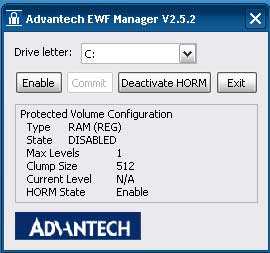 The Advantech Enhanced Write Filter Manager was installed on our test machine and I'll briefly describe it as it'll be of interest to many potential users of the PPC-6170. Enhanced Write Filter, or EWF, is an interesting security feature supported by the Windows Embedded operating systems. The Advantech Enhanced Write Filter Manager was installed on our test machine and I'll briefly describe it as it'll be of interest to many potential users of the PPC-6170. Enhanced Write Filter, or EWF, is an interesting security feature supported by the Windows Embedded operating systems.
What the Enhanced Write Filter does is provide the ability to write-protect a run-time image. It does that by redirecting write operations to another storage location and totally write-protects the run-time image, thus preventing any damage that might be caused by an unexpected power failure, vibration or even a virus attack.
Taking full advantage of EWF technology requires some studying and proper configuration of a system. To learn more about this particular feature of Windows Embedded, read the EFW Manager and EWF Components sections at the Microsoft Embedded Developer Center.
Ruggedness
As a panel PC, the Advantech PPC-6170 has different ruggedness requirements than a mobile computer. It's not likely to get dropped since it will be installed in a panel or other stationary setting. And since it is most likely used indoors, it won't get rained on. However, it is expected to run reliably 24/7 in factory settings where temperature, vibration, and exposure to water still can be issues.
As a result, the PPC-6170 is sturdy and very well built. The industrial plastic bezel and housing won't easily scratch or break. When mounted in a panel, a neoprene gasket behind the bezel lip effectively seals the computer. So while the housing itself has ventilation slots and standard connectors, from the front the system carries the equivalent of IP65 sealing. This means that a panel with the PPC-6170 installed could be hosed down and not incur any damage.
In terms of operating temperature, panels are not generally installed freezers, and so the device is designed to operate within a range of 32 to 122 degrees Fahrenheit, well beyond the range where human operators can comfortably work.
Advantech does provide shock test figures and certifies the panel to 10G peak acceleration for a duration of 11 msec.
Bottom line: Advantech PPC-6170 Panel PC
The Advantech PPC-6170 is a versatile industrial panel computer from an experienced Taiwanese embedded and industrial systems manufacturer with a worldwide presence. Available with a wide range of processors and options, the panel can be equipped and optimized for numerous applications.
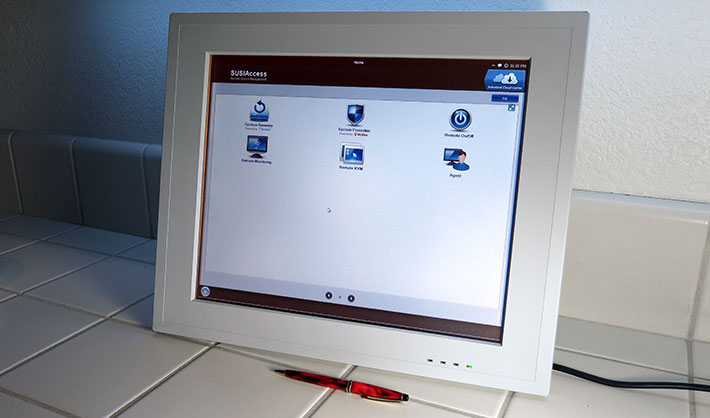
The PPC-6170 is generally configured as an embedded device running either the Windows XP Embedded or Windows Embedded Standard 7 operating systems from an internal SATA hard disk, though the standard versions of XP and Windows 7 are available as well. The unit comes with up to a 8GB of DDR3 RAM in a single SODIMM slot. The Intel Core i5-3610ME processor in our review unit provided excellent performance for virtually any application. When mounted in a panel, the PPC-6170's front bezel is sealed to IP65 specifications. The unit is designed to handle the abuse (shock, temperature, humidity, etc.) likely encountered in an industrial environment.
Advantech offers panel computers with a wide variety of screen sizes and touchscreen technologies. The PPC-6170 with its 17-inch SXGA touch display is large enough for just about any human interface project. The display is bright, has excellent viewing angles, and is quite immune to smudges and fingerprints. The analog resistive 5-wire touch screen that was very responsive and highly configurable for optimal use with both a stylus or fingers.
The PPC-6170 offers excellent onboard connectivity for use with a variety of current or legacy devices and peripherals. You get three external USB 3.0 and two USB 2.0 ports, three RS232 and RS232/422/485/TTL serial ports, VGA and HDMI video for an additional video feed, and dual LAN (ours had four additional RJ45 jacks). There are internal PCI and PCIe slots, and an an additional optional riser card can add more.
The PPC-6170 is a cleanly designed, no-nonsense panel computer that combines versatility, ruggedness, easy customization and maintenance, and a very wide range of performance. It can be configured for a large variety of applications in all kinds of manufacturing and industrial settings, with application in numerous other settings as well.
-- Conrad H. Blickenstorfer, August 2014
Advantech PPC-6170 specs:
| Status |
Added 08/2014
|
| Type |
Panel PC
|
| CPU Type |
Intel Core i5-3610ME; also available with Core i3-3120ME, Celeron 847E, Celeron 1020E
|
| Chipset |
Intel QM77
|
| BIOS |
Unknown
|
| OS |
Windows 7 (32 and 64-bit), Windows Embedded Standard 7 (32 and 64-bit), Windows XP Embedded, Windows XP
|
| API support |
iManager, SUSIAccess and Embedded Software APIs
|
| Memory |
Max 8GB DDR3 1600MHz or DDR3L 1333MHz via 1 x 204-pin SODIMM slot
|
| Graphics Controller |
Intel HD Graphics 4000 (integrated)
|
| Video-out |
1 x VGA, 1 X HDMI
|
| Display |
LCD with 350 nits LED backlight, 170° horizontal and 160° vertical viewing angle
|
| Display size/res |
17-inch/1280 x 1024 pixel
|
| Touch size/res |
Analog resistive 5-2ire
|
| LAN |
2 x RJ45 10/100/1000 (GbE1 is Intel 82579LM, GbE2 is Intel 82583V)
|
| SATA |
1 x 2.5-inch SATA/300 bay plus either second 2.5-inch SATA bay or optical drive |
| IDE/EIDE |
NA
|
| SSD |
via mSATA
|
| Expansion: PCI |
Standard: 1 x PCI, 1 x PCIe;
optional: 2 x PCIe x1 or 2 x PCI, 1 x full-size mini PCIe (supports mSATA), 1 x half-size mini PCIe
|
| USB |
3 x USB 2.0, 2 x USB 2.0 |
| Serial |
3 x RS232, 1 x isolated RS232/422/485
|
| Audio |
1 x line-out, 1 x mic, 2 x 1W speakers
|
| GPIO |
1 x DB9 GPIO/RS232 (8 channels, TTL level)
|
| Watchdog Timer |
Yes, 1 (System reset, programmable 1 ~ 255 sec/min) |
| Size |
17.4 x 14.3 x 4.5 inches (442 x 362 x 114 mm)
|
| Weight |
16.5 lbs (7.5 kg)
|
| Operating Temp. |
With HD: 32° to 122°F (0° to 50°C) |
| Sealing |
IP65-protected front bezel
|
| Shock |
Operating 10 G peak acceleration (11 ms duration), per IEC 60068-2-27
|
| EMC |
BSMI, CE, FCC Class A
|
| Safety |
CB, CCC, BSMI, UL
|
| Vibration |
Operating Random Vibration Test 5~500Hz, 1Grms, per IEC 60068-2-64
|
| Price |
Mid-range version ~ US$1,900
|
| Web page |
 PPC-6170 page PPC-6170 page |
| Datasheet |
 PPC-6170 spec sheet PPC-6170 spec sheet |
Advantech Corporation
13 Whatney
Irvine, CA 92618
Toll Free: 1-800-866-6008
Ph: 949-420-2500
Fax: 949-420-2501
ECGInfo@advantech.com
www.advantech.com
Advantech Co. Ltd.
No.1, Alley 20, Lane 26, Rueiguang Road
Neihu District, Taipei Taiwan 114, R.O.C.
Tel: 886-2-2792-7818
Fax: 886-2-2794-7301
www.advantech.com
|



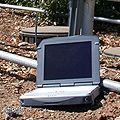


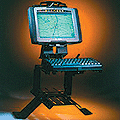







 The PPC-6170's manual shows how to open the panel to install memory, an optional optical drive, a different hard drive and/or a second hard drive, as well as mini-SATA and wireless network cards. It also shows how to install optional riser cards.
The PPC-6170's manual shows how to open the panel to install memory, an optional optical drive, a different hard drive and/or a second hard drive, as well as mini-SATA and wireless network cards. It also shows how to install optional riser cards.

 Some commentary about the available chips: three of them are of the "Ivy Bridge" 3rd generation of Core processors, and one is from the predecessor "Sandy Bridge" 2nd generation. What's the difference? Using the 22nm manufacturing process, "Ivy Bridge" brought increased efficiency, lower power consumption, and much better graphics performance. Add to that native USB 3.0 and PCIe 3.0 support in higher-end chips and it's no surprise that Advantech built this panel primarily for Ivy Bridge chips. However, the 3rd Gen is cross-compatible with the 2nd Gen, and so Advantech threw in the low-end Sandy Bridge Celeron.
Some commentary about the available chips: three of them are of the "Ivy Bridge" 3rd generation of Core processors, and one is from the predecessor "Sandy Bridge" 2nd generation. What's the difference? Using the 22nm manufacturing process, "Ivy Bridge" brought increased efficiency, lower power consumption, and much better graphics performance. Add to that native USB 3.0 and PCIe 3.0 support in higher-end chips and it's no surprise that Advantech built this panel primarily for Ivy Bridge chips. However, the 3rd Gen is cross-compatible with the 2nd Gen, and so Advantech threw in the low-end Sandy Bridge Celeron.

 SUSIAccess, preloaded in all Advantech embedded solutions and a demo was also on our review machine, is a remote device management software suite that allows remote device monitoring, cross-platform access, real-time remote configuration, as well as Acronis system recovery and backup. SUSIAccess also provides system security via McAfee Embedded Security solutions, automatic alerts, and remote keyboard, mouse and video access.
SUSIAccess, preloaded in all Advantech embedded solutions and a demo was also on our review machine, is a remote device management software suite that allows remote device monitoring, cross-platform access, real-time remote configuration, as well as Acronis system recovery and backup. SUSIAccess also provides system security via McAfee Embedded Security solutions, automatic alerts, and remote keyboard, mouse and video access.
 The Advantech Enhanced Write Filter Manager was installed on our test machine and I'll briefly describe it as it'll be of interest to many potential users of the PPC-6170. Enhanced Write Filter, or EWF, is an interesting security feature supported by the Windows Embedded operating systems.
The Advantech Enhanced Write Filter Manager was installed on our test machine and I'll briefly describe it as it'll be of interest to many potential users of the PPC-6170. Enhanced Write Filter, or EWF, is an interesting security feature supported by the Windows Embedded operating systems.

